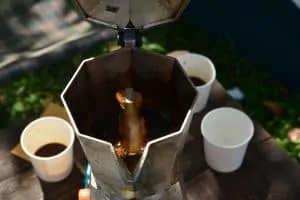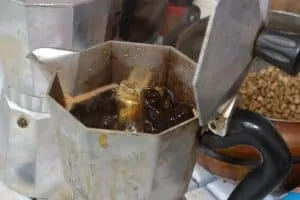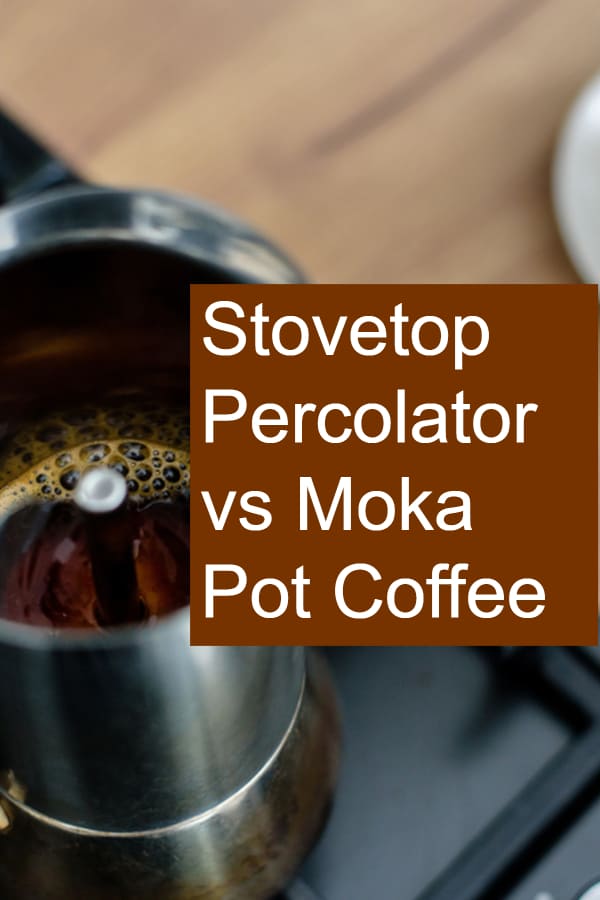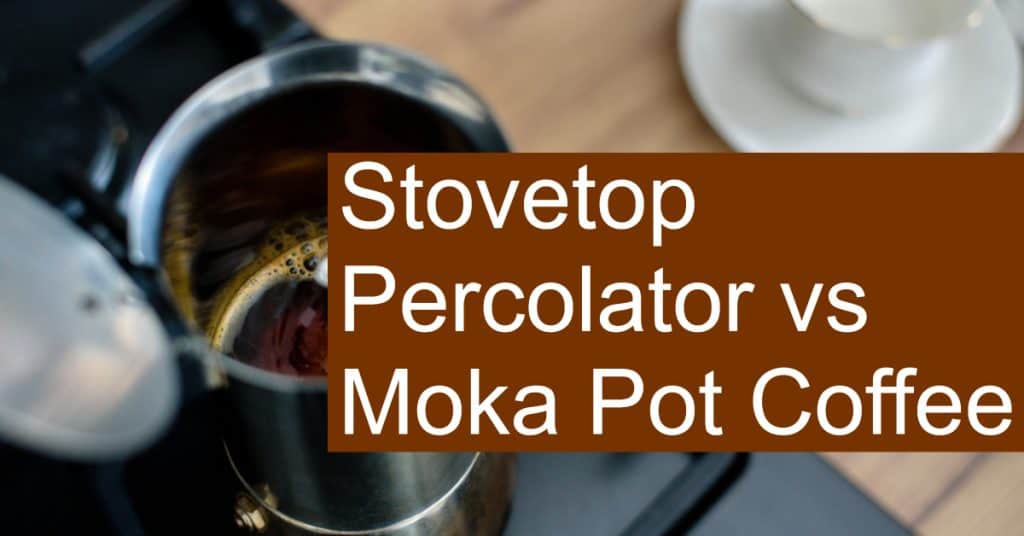At one time, most coffee pots in most homes were the percolator type. A percolator makes a really cool sound, almost a popping sound, and therefore it not only makes great coffee, but it’s also a lot of fun to use.
At first glance, it seems that a Moka Pot is similar. Yet, there are a few differences you want to be aware of. Let’s have a closer look at Moka Pot vs Percolator and figure out which makes better coffee!
You can even lift the lid with the tiny handle and watch the coffee “percolate” if you like, and as soon as the sound stops, you know it’s ready. Percolators are single units and are essentially made of the chamber and a filter basket.
Is a Moka Pot Just a Different Type of Percolator?
On the other hand, a Moka pot consists of three separate parts:
- A water chamber
- A middle section that is there to carry the ground filter
- A top section that helps make the coffee
Moka pots are stovetop coffee pots and work a little differently than percolators. They are often called a stovetop espresso machine because the coffee they make tastes a lot like espresso. As a general rule, the only similarity comparing Moka pot vs percolator is that they are both stovetop coffee pots that you can make coffee with using ground coffee. Once you get past that, they are very different in many ways.
Do Percolators and Moka Pots Brew Coffee the Same Way?
Percolators and Moka pots brew coffee in entirely different ways. Percolators boil water continuously, and the water stays in the bottom section of the pot to make coffee and keep it warm. You pour water into the pot and it goes into the bottom section where the ground coffee is.
This means that once the boiling hot water gets down there, the coffee grounds become the liquid coffee that you drink. There isn’t a middle section that the water goes into before the liquid coffee is dripped down into a separate container, like a Moka pot.

With a percolator, you have a clear cap on the lid that you can actually see the perked coffee in as it’s percolating. This is entertaining and interesting at the very least. Since the water is continuously boiling and being poured over the grounds, you’ll have to remove the pot from the heat source for it to stop. The brewed coffee made from a percolator tastes a lot like French press or drip, and many people use a coarser grind for percolators than they do for Moka pots.
Moka pots are also used on the stovetop just like a percolator, but they consist of three different parts. You often can see them advertised as a stovetop espresso maker and you can find them made from aluminum or stainless steel. The bottom part holds the water and a perforated cone-like device with coffee grounds is placed in that water. The water is heated until it changes into steam.
This process builds up a lot of pressure forcing the steam through the espresso grounds until it ends up in the chamber that sits at the top of the device. Although people think of this type of coffee as espresso, it is slightly different because the pressure that builds up inside the coffee pot is a lot weaker than with an espresso machine. Still, the results are nothing short of delicious, which is why these types of coffee pots are so popular.
Moka pots make a brewed coffee that tastes like either espresso or Turkish coffee, and most people choose grounds that are a little finer than those used in a percolator. This is partly why the coffee comes out tasting the way it does.
Does Coffee Have Calories? How many Calories are in Black Coffee?
Which Is Easier to Brew?
When you’re looking at easy-of-use for the Moka pot vs percolator, then neither brewing methods or coffee maker is difficult to maneuver because all you do is make sure they are put together properly and then pour the coffee grounds and/or the water into each compartment.
Usually, both of these devices are held over a burner on your stove. They do not have their own heat source and use your stovetop as the heat source. Overall, however, a percolator is slower than a Moka pot coffee maker. If you’re looking for a quick cup of coffee and you have a choice between a percolator and a Moka pot, you should definitely choose the latter.
Some newer “stovetop” coffee pots are now electric, which makes both of them have a faster brewing process than they were in the beginning. Nevertheless, most people prefer a true stovetop percolator or Moka coffee pot over these newfangled electric ones. A percolator is always going to be more time-consuming to get a coffee than a Moka pot.
What Kind of Grind Do You Need? Fine? Coarse?

As a general rule, people tend to put coarser coffee grounds in a percolator than they do in a Moka pot. Part of the reason is that since a Moka pot takes a much shorter time to brew the coffee, coarser ground coffee may not have time to make a good, strong coffee cup in the end. With a Moka pot, the espresso grounds need time to be extracted as the coffee is being brewed, and you don’t have enough time for that extraction to take place if the grounds are coarse.
On the other hand, since a percolator has a lot longer brewing process, coarse coffee grounds are acceptable for these coffee makers because they have time to go through the brewing process and turn out yummy in the end. In short, you need more time with coarse grounds so that they have time to brew all the way and taste the way they’re supposed to taste.
This is similar to brewing with a French Press where you let the coffee steep for a while before pouring it. This won’t happen with a Moka pot because the brewing time is so short. This is why it’s always best to use finer grounds in a Moka pot and save the coarser grounds for the percolator or French Press coffee.
What Type of Roast Produces Better Coffee? Dark? Light?
Whether you use coarse or fine grounds, you’ll have to decide between dark or light roast for the coffee machine you choose. The lighter the roast, the less time they spend in the roaster, which produces a completely different taste than coffee beans that spend more time roasting. As a general rule, when coffee beans are only lightly roasted, they have more caffeine, more moisture, and more density. Light-roasted coffee beans are also a little more acidic and have a taste that is herbal and fruity.

On the other hand, dark-roasted coffee beans are roasted longer, and therefore, they lose some of their caffeine and moisture. Their taste is more of a combination of graham crackers, nuts, and caramel.
They are less dense than light-roasted beans but have a flavor that is more like a “typical” coffee made with a drip coffee maker. Although dark roasts have a bolder flavor, they have a lot less caffeine than light roasts do and less moisture.
This is what surprises most people when they research light-roasted coffee versus dark-roasted coffee. Dark-roasted coffee is bold in flavor, yes, but since it is roasted longer, it has less caffeine and a taste that isn’t as strong as light-roasted coffee. In other words, if you want a strong cup of coffee with a lot of caffeine in it, you’ll want to go with a light-roasted coffee, not something dark-roasted.
Is a Percolator Less Expensive Than a Moka Pot?
When brewing your coffee every morning, you’re doing more than just fixing yourself a caffeine-filled drink. You’re enjoying an experience, and both percolators and Moka pots contribute to that experience. Many factors go into the price of your coffee pot, including the size, the brand, and how many fancy features it has. Thus, it is sometimes difficult to compare these two types of coffee-makers because it is a lot like comparing apples to oranges.

Stovetop percolators are usually lower in price compared to an equally sized Moka pot. Even electric percolators are not that expensive. A Moka pot will typically also not rip a big hole into your wallet.
Most of the Moka coffee/espresso pots are a little more expensive than the percolator pots. This might be because a Moka pot is a bit more specialized and has a few more components. Percolators are more straightforward in design than Moka pots are, and therefore, they usually don’t cost as much money.
There is the possibility that you could find a percolator that is more expensive than a Moka pot. Still, in general, a Moka pot is almost always going to cost more than percolators.
Final Thoughts
Although Moka pots and percolators both make great cups of coffee, the coffee they make and how they make that coffee is very different. If you want coffee that tastes like Turkish or espresso coffee, you’ll want to choose the Moka coffee pot.
On the other hand, if a French press or drip-type coffee is what you’re looking for, you should choose a percolator. Both are easy to research and easy to use, and you can get them online at any time. Even better, both make fresh, delicious coffee that is good for everyday use and special occasions, so they are versatile coffee pots that you’ll be able to enjoy for many years to come.


